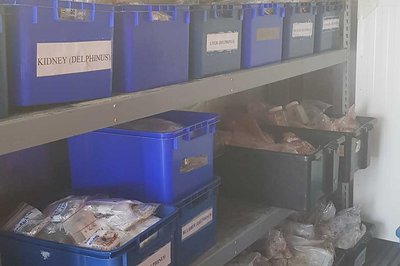
Associate Professor Karen Stockin and her team from the Cetacean Ecology Research Group (CERG) at Massey University were relieved to take delivery of their new 20ft walk in freezer last week to safely store the largest marine mammal tissue archive in the southern hemisphere.
The new container freezer now houses over 12,000 tissues representing more than 25 cetacean (whale and dolphin) species sampled from around New Zealand and beyond since the early 1990s.
The archive contains various tissue types including liver, kidney, heart, muscle, gonads, stomach contents and teeth from all manner of coastal and oceanic dolphins through to pelagic beaked and migratory baleen whales.
Dr Stockin says, “It is a real privilege to be able curate such a culturally and scientifically important archive on behalf of mana whenua and the Department of Conservation,”.
Over the past 30 years, the tissues have formed part of Massey University’s ongoing marine mammal research programme which has resulted in a significant number of published studies being conducted by CERG’s staff and postgraduate students.
Massey’s history of marine mammal research dates back to Professor David Blackmore, who in 1991 was invited by the International Whaling Commission (IWC) to investigate methods used for the slaughter of whales.
Professor Blackmore, who was based at the School of Veterinary Science went on to establish the New Zealand Foundation for the Study of the Welfare of Whales, examining anatomical and biophysical features in dead whales.

Thirty years on, Massey continues its focus on marine mammals, tackling bycatch, disease, toxicology, health and welfare a part of its increasing spectrum of research.
Involving staff and students across the College of Science, Massey University has influenced government policy on everything from tourism impacts to toxoplasmosis.
The university also continues to be represented at global level within the IWC with Dr Stockin appointed as the IWC inaugural Stranding Coordinator in 2018 and a current member of their Stranding Expert Panel.
“As we transferred the tissue archive over into the new freezer, I was reminded of how incredibly honoured and humbled we are both in New Zealand and Massey University to be custodians of such precious taonga,” Dr Stockin says.
With animals being systematically sampled for over three decades, Massey and CERG are now poised to address some of the most challenging questions about how our marine species are adapting to a changing environment.
Recently the team published a study on the changing diet of Hauraki Gulf common dolphins using tissues from this archive.
The CERG team is also currently working with the Department of Conservation, Institute of Environmental Science and Research (ESR) and other stakeholders on projects which examine the impact of climate change and the effects of emerging contaminants including microplastics on New Zealand’s marine mammals.
“All this is possible thanks to the time series samples collected post-mortem from strandings and bycatch events over the decades,” Dr Stockin added.
Massey University has attracted international attention for the rare and cryptic species it has examined at its Auckland campus, including earlier this year when Dr Stockin and the team dissected their second elusive hourglass dolphin.
“This archive has supported no end of postgraduate projects, including my own,” she says.
As a former PhD student under the supervision of former Massey vet pathologist Professor Padraig Duignan, Dr Stockin’s doctoral studies examined, amongst other things, the contaminants in New Zealand common dolphins, using the tissue archive.
Today, Dr Stockin and her colleague Dr Emma Betty, also based within CERG, supervise the next generation of marine mammal scientists who currently use the tissue archive to address evolving questions around marine mammal health, life history and ecology.